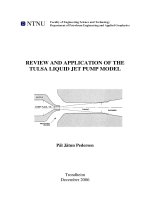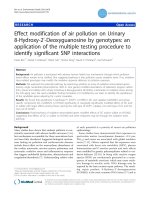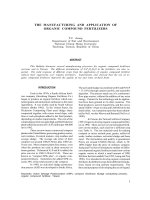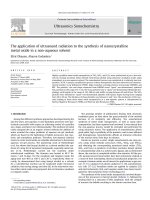- Trang chủ >>
- Khoa Học Tự Nhiên >>
- Vật lý
the application of ultrasound radiation to the synthesis of nanocrystalline
Bạn đang xem bản rút gọn của tài liệu. Xem và tải ngay bản đầy đủ của tài liệu tại đây (467.24 KB, 6 trang )
The application of ultrasound radiation to the synthesis of nanocrystalline
metal oxide in a non-aqueous solvent
Efrat Ohayon, Aharon Gedanken
*
Department of Chemistry, Kanbar Laboratory for Nanomaterials, Nanotechnology Research Center, Institute of Nanotechnology and Advanced Materials, Bar-Ilan University,
Ramat-Gan 52900, Israel
article info
Article history:
Received 17 March 2009
Received in revised form 14 May 2009
Accepted 15 May 2009
Available online 22 May 2009
Keywords:
Sonochemistry
Nanoparticles
Non-aqueous solvent
Microwave
abstract
Highly crystalline metal oxide nanoparticles of TiO
2
,WO
3
, and V
2
O
5
were synthesized in just a few min-
utes by reacting transition metal chloride with benzyl alcohol using ultrasonic irradiation under argon
atmosphere in a non-aqueous solvent. The sonochemical process was conducted at a relatively low tem-
perature, 363 K. A unique crystallization process of these nanoparticles has been observed and character-
ized by powder X-ray diffraction (PXRD), high resolution scanning electron microscopy (HRSEM), and
BET. The particles’ size and shape measured from HRSEM reveal ‘‘quasi” zero-dimensional, spherical
TiO
2
particles in the range of 3–7 nm. The V
2
O
5
particles have a ‘‘quasi” one-dimensional ellipsoidal mor-
phology, with lengths in the range of 150–200 nm and widths varying between 40 and 60 nm. The WO
3
particles were obtained as ‘‘quasi” two-dimensional platelets with square shapes having facets ranging
from 30 to 50 nm. The thickness of these platelets was between 2 and 7 nm. The mechanism of the reac-
tions leading to these three metal oxide nanoparticles in a non-aqueous system is substantiated by
Nuclear Magnetic Resonance (NMR), and Electron Spin Resonance (ESR).
Ó 2009 Elsevier B.V. All rights reserved.
1. Introduction
Among the different synthesis approaches developed during the
last few years, non-aqueous or non-hydrolytic processes were par-
ticularly successful with respect to achieving control of crystallite
size, shape, and hence over dimensionality. The synthesis of metal
oxide nanoparticles in an organic solvent without the addition of
water avoided the major problems of aqueous sol–gel methods,
which are based on the hydrolysis of halide precursors, fast reac-
tions, and amorphous products. Therefore, non-aqueous solution
routes to create metal oxide are valuable alternatives to the known
aqueous sol–gel process. The pioneering work of Niederberger
et al. has shown that benzyl alcohol as a solvent enabled the syn-
thesis of a long list of nanosized compounds, especially metal oxi-
des [1–5]. Niederberger carried out the reactions under
solvothermal conditions. The titanium was heated to 40 °C be-
tween 7 and 14 days. For the vanadium and tungsten oxide, the
aging time was 48 h at 100 °C and 120 °C, respectively. More re-
cently, he demonstrated that using benzyl alcohol as a solvent
for a solvothermal reaction can be conducted under microwave
radiation, thus saving energy and time [6]. In the microwave reac-
tion other metal oxides were prepared, but not titanium, vanadium
or tungsten oxides.
The growing number of publications dealing with ultrasonic
irradiation gives an idea about the great potential of the method
because of its simplicity and efficiency. The sonochemical
synthesis of metal oxide nanoparticles, as well as many other
nanoparticles, has been reported and reviewed. It was natural that
the non-aqueous process would be extended and performed by
using ultrasonic waves. The application of sonochemistry allows
good yields, high crystallinity of the products, and is more efficient
and homogeneous. Sonochemistry affords an immense reduction
of the reaction time, from days to minutes.
Herein we present a novel, simple sonochemical one-step pro-
cess using metal chloride precursors (TiCl
4
, WCl
6
, and VOCl
3
),
and obtaining the corresponding nanosized metal oxides (TiO
2
,
WO
3
, and V
2
O
5
) as products. In all three reactions, benzyl alcohol
is simultaneously used as a solvent and a ligand, and as mentioned
above, the reaction is completed within a few minutes. All the spe-
cific nanostructured metal oxides have been intensively studied as
a result of their outstanding chemical and physical properties. For
example, titanium oxides are of interest for applications as gas sen-
sors [7–11], catalysts [12], photo catalysts [13–16], and photovol-
taic cells [17–22]. Vanadium oxides are applied in catalysis [23]
and electrochemistry [24], and tungsten oxides have been investi-
gated for electrochromic device technology [25].
The synthesis of the metal oxide nanoparticles involved disper-
sion of the precursors in benzyl alcohol (Scheme 1), followed by
heating them in a sonicator of 60% amplitude, with the collapse
of acoustic the bubble resulting in the shorter reaction time.
1350-4177/$ - see front matter Ó 2009 Elsevier B.V. All rights reserved.
doi:10.1016/j.ultsonch.2009.05.015
* Corresponding author.
E-mail address: (A. Gedanken).
Ultrasonics Sonochemistry 17 (2010) 173–178
Contents lists available at ScienceDirect
Ultrasonics Sonochemistry
journal homepage: www.elsevier.com/locate/ultsonch
2. Experimental section
2.1. Materials
Titanium (IV) chloride (99.9%), Vanadium (V) oxychloride
(99.99%), tungsten (VI) chloride (powder 99.9%) and benzyl alcohol
(99.8%, anhydrous) were obtained from Aldrich. These chemicals
were used without further purification.
2.2. Synthesis of the metal oxide nanoparticles
In a typical preparation, the transition metal chloride, 0.5 mL of
TiCl
4
(4.5 mmol), 400 mg of WCl
6
(1 mmol), and 0.5 mL of VOCl
3
(5.3 mmol), was slowly added to 20 mL of benzyl alcohol
(0.193 mol) under vigorous stirring at room temperature. All the
materials were introduced into the sonication cell under inert
atmosphere in a glove box. The reaction mixture was sonicated un-
der argon–hydrogen atmosphere (60% amplitude). The reaction
time differed depending on the precursor. For the vanadium and
the titania, the sonication time was 10 min. The tungsten precursor
required between 5 and 7 min to fully react. The sonication was
conducted without cooling so that a temperature of 363 K was
reached at the end of the reaction. The resulting suspensions were
centrifuged and the precipitate was thoroughly washed three
times with ethanol (1 Â 20 mL) and THF (2 Â 20 mL). The collected
material was left to dry in air and finally ground into a powder.
After grinding, the powders were weighed and good yields (85–
95%) were obtained for all three reactions. Care should be taken
as the reaction is rather violent.
3. Analysis and characterization
The XRD crystallinity and particle size were investigated by X-
ray diffraction (XRD). XRD measurements carried out using a Mod-
el-2028 (Rigaku) diffractometer. Transmission electron microscopy
(TEM) samples were prepared by depositing one drop of the solu-
tion on a 400 mesh copper grid coated with carbon and dried over-
night under vacuum. The transmission electron micrographs were
obtained with a JEOL JEM-1200EX electron microscope. A Scion Im-
age software program was used to measure the mean particle size
of the nanoparticles from the HRSEM. High resolution scanning
electron microscopy (HR-SEM) micrographs were obtained using
a JEOL-JSM 700F instrument and a LEO Gemini 982 field emission
gun SEM (FEG-SEM). The BET surface area measurements were
characterized by nitrogen adsorption at 77 K. The domestic micro-
wave oven (DMO) operates at 2.45 GHz, under argon atmosphere
with a power of 900 W output. A white product was obtained for
the titanium reaction. The tungsten product was yellow. The color
of the as-prepared vanadium material was black. After heating to
450 °C, the color of the powder turned to orange.
4. Results and discussion
In contrast to most of the sol–gel processes that lead to amor-
phous materials, our synthesized products are highly crystalline.
Powder X-ray diffraction (PXRD) patterns of the obtained materials
are shown in Fig. 1. The white titania sample consists of a pure ana-
tase phase without any indication of other crystalline products
(Fig. 1a). The broad diffraction peaks obtained for the titania and
the WO
3
indicate clearly the nanosized nature of the as-prepared
products. The XRD powder patterns of the TiO
2
,V
2
O
5
, and WO
3
show diffraction peaks that match well with the PDF tables (01-
086-1157), (03-065-013), and (00-041-0905), respectively. The
pattern of the yellow particles fits the WO
3
data (Fig. 1b). The
XRD diffraction pattern of the as-prepared black vanadium oxide
powder can not be assigned to a specific vanadium oxide phase.
We interpret the as-prepared product as being composed of a mix-
ture of vanadium oxides. EDX measurements of the as-prepared
product indicate the presence of only vanadium, oxygen, and car-
bon. Heating the vanadium mixture to 450 °C has led to the forma-
tion of a single-phase crystalline V
2
O
5
(Fig. 1c). The average
crystallite size estimated using the Scherrer equation is about
10–15 nm for the titania. The vanadium and tungsten oxide sizes
were about 45–64 nm, and 13–20 nm, respectively (Table 1). It is
worth noting that in a recent paper by Niederberger et al. [35],
the reaction between VOCl
3
and benzyl alcohol has led to the
formation of VO
1.52
(OH)
0.77
. The reaction was conducted under
conventional heating for 24 h at 150 °C. That means that conven-
tional heating produces different product from our V
2
O
5
.
Representative high resolution scanning electron microscopy
(HRSEM) images are presented in Fig. 2 and were used to calculate
the size distribution of the products. A highly aggregated morphol-
ogy is illustrated in Fig. 2a, which depicts the titania product. The
aggregate consists of ‘‘quasi” zero-dimensional particles having a
diameter ranging from 3 to 7 nm (Fig. 2a). After annealing the
vanadium, the oxide sample exhibits rather uniform ellipsoidal
particle morphology, ‘‘quasi” one-dimensional, with lengths rang-
Scheme 1. General reaction scheme displaying the metal oxide precursors used the
solvent, the experimental condition and the resulting metal oxide nanoparticles.
2θ (degree)
20 30 40 50 60 70 80
Intensity (a.u.)
(a)
(b)
(c)
Fig. 1. XRD of: (a) as-prepared pure anatase phase TiO
2
, (b) yellow WO
3
, and (c) single-phase V
2
O
5
(after heating at 450 °C).
174 E. Ohayon, A. Gedanken / Ultrasonics Sonochemistry 17 (2010) 173–178
ing from 150 to 200 nm and diameters varying between 40 and
60 nm (Fig. 2b). The length for the mixed valent vanadium oxide,
the as-prepared material, is between 150 and 250 nm, and the
diameter varies between 30 and 60 nm. This means that upon
the annealing process, the product does not undergo any morpho-
logical changes.
The tungsten oxide forms nearly square, ‘‘quasi” two-dimen-
sional platelets. These nanoparticles have facets ranging from 30
to 50 nm (Fig. 2c). Side views of particles that are oriented verti-
cally to the SEM grid reveal that the thickness is between 2 and
7 nm. These HRSEM images prove that all the three nanomaterials
have a high crystallinity and their size is in good agreement with
the size calculated from the powder XRD patterns recorded for
the same sample.
In our case, the BET surface area of the nanoparticles synthe-
sized by microwaves is higher than that synthesized by an ultra-
sonic route, apart from titania. The BET surface area of TiO
2
,
V
2
O
5
, and WO
3
, which were prepared in ultrasonic irradiation,
are 162.6, and 47 m
2
/g, while that of microwave are 124, 12, and
77 m
2
/g, respectively.
Like the surface area, the particle size also depends on the reac-
tion device/method. Although particle-size determination by peak
broadening is not a very accurate method, the results coincide well
with HRSEM measurements (Table 1). As expected, the decrease in
particle size is expressed in larger surface areas. We have also syn-
thesized the same products in a domestic microwave oven. The
precursors and the solvents were identical to those in the sono-
chemistry reaction. The microwave and sonochemical results of
the BET surface area and the crystallite size of all the materials,
as obtained from HRSEM and from XRD by the Scherrer equation,
are presented in Table 1.
4.1. Reaction mechanisms of metal oxide particles in non-aqueous
synthesis
This section will discuss the organic side of the synthesis of
inorganic nanomaterials performed in non-aqueous, but liquid
reaction media. The organic components and the organic reaction
pathways play a fundamental role in the non-aqueous synthesis
of the inorganic products. In this process, the formal oxygen that
is required for the fabrication of the metal oxide is not provided
by any added water. Therefore, it must stem from the precursor
of the organic media. In our case, the benzyl alcohol is used as
the oxygen source. It is clear that in our process the organic solvent
serves as a solvent as well as a reactant, thus playing a major role
in the formation of the product. Generally, two possible organic
mechanisms are suggested for providing the oxygen to enable
the formation of the metal oxide nanostructure. The first is the al-
kyl/halide elimination mechanism [26,27]. Metal halides are popu-
lar precursors due to their good commercial availability and their
comparatively low cost. In alcohol solvents, the alcohol oxygen is
rapidly coordinated to the metal centre, which is followed by an
elimination reaction. Basically, two elimination mechanisms can
occur: a reaction that directly promotes the formation of the metal
oxide by an alkyl halide elimination (Scheme 2, Eq. 1), which may
be adequately termed as a hydroxylation process [28]. In this case,
a metal-coordinated hydroxyl group is formed that instantly reacts
with the precursor to form metal–oxygen–metal groups (Scheme
2, Eq. 2). The combination of these two equations leads to the elim-
ination of R–X and H–X. The other possibility is the elimination of
only hydrogen halide. This mechanism constitutes a ligand ex-
change reaction [29] (Scheme 3, Eq. 3).
The second possible mechanism is related to radicals involved
in the reaction as a result of the bubble’s collapse. Application of
ultrasound to chemical processes involves the use of acoustic cav-
itation. Acoustic cavitation involves the nucleation, growth, and
sudden collapse of the gas of vapor-filled microbubbles formed
from acoustical wave-induced compression/rarefaction in a body
of liquid [30]. The implosion of the microscopic bubbles in the li-
quid generates energy, which induces chemical and mechanical ef-
fects. It is well known that the sudden collapse leads to
localization, a transient high temperature (P5000 K) and pressures
(P1000 atm), resulting in an oxidative environment due to the
generation of highly reactive species, including hydroxyl radical
(
Å
OH) [31,32]. This mechanism governs mostly sonochemical reac-
tions conducted in aqueous solutions. We have examined whether
OH radicals are formed when a bubble collapses in a benzyl alcohol
solution. The following experimental technique was employed in
this probe.
ESR: to 20 ml of benzyl alcohol a small amount of a TEMPO trap
was added and the sonication took place under identical conditions
to those of the synthesis of the metal oxides. It is assumed that if
hydroxyl radicals are formed they will be trapped by the TEMPO
molecules, and their presence can be detected by electron spin res-
onance measurements.
Since the possibility of the involvement of hydroxyl radicals is
eliminated, we are back to the proposed mechanism of Schemes
2 and 3. To substantiate these mechanisms further experimenta-
tion and calculation were performed. They are outlined below.
1
H NMR: the information about the reaction pathway can be
found by identifying the organic products, which are present in
the final reaction mixture. The
1
H NMR spectra of the pure benzyl
alcohol and of the final reaction mixture are presented in Fig. 3a
and b, respectively. According to Fig. 3a of the benzyl alcohol, there
are three main peaks. The multiplet peaks at 7.25 ppm resulted
from the benzene ring proton in the benzyl alcohol structure. Addi-
tionally, the strong singlet peak at 4.5 ppm refers to the methyl
group, whereas the weak singlet peak at 3.3 ppm refers to the
OH group. The integration ratios of the benzene ring, the methyl
group and the OH peak are 1:0.4:0.2, respectively.
The triplet peak at 1.1 ppm and the quartet peak at 3.5 ppm are
assigned to the CH
3
and CH
2
groups of ethanol, respectively.
According to these benzyl alcohol spectra and the literature values,
the
1
H NMR results show that in a pure TiCl
4
/benzyl alcohol system,
Table 1
Overview of the surface area and particle sizes calculated from HRSEM and XRD data with a reaction yield.
Sample XRD particle size (nm)
a
HRSEM particle size (nm) BET surface area (m
2
/g) Reaction yield (%)
TiO
2
Ultrasonic 10–15 3–7 162.6 85–90
Microwave 12–20 12–15 124 90
V
2
O
5
Ultrasonic 45–64
b
40–60 6 80–85
Microwave 45–55
b
45–65 12 85
WO
3
Ultrasonic 7–15
b
2–7 47 80–90
Microwave 10–15
b
4–8 59–77 90–92
a
The average crystallite size was calculated using the Scherrer equation.
b
These results are assigned to the average size of the thickness.
E. Ohayon, A. Gedanken / Ultrasonics Sonochemistry 17 (2010) 173–178
175
the final reaction solution contained benzyl chloride. The results/
spectra of the final reaction solution are presented in Fig. 3b. As op-
posed to benzyl alcohol spectra, in the final reaction the spectra ex-
hibit only two peaks. The multiplet peaks at 7.33 ppm resulted from
the benzene ring proton in the benzyl chloride structure, and the
strong singlet peak at 4.66 ppm refers to the methyl chloride group.
Scheme 2.
Scheme 3.
Fig. 2. HR-SEM micrographs of: (a) crystalline anatase TiO
2
; mean particle size is .7 ± 1.0 nm, (b) vanadium mixture after heating (single-phase V
2
O
5
), mean lengths size is
175 ± 20 nm, and mean diameters is 50 ± 10, (c) WO
3
, mean particle size is .41.2 ± 5.9 nm and mean thickness is 6.3 ± 1.5.
176 E. Ohayon, A. Gedanken / Ultrasonics Sonochemistry 17 (2010) 173–178
This NMR result demonstrates that in this reaction system benzyl
chloride was present as a reaction product.
It is well known that sonochemistry is carried out at a much
higher temperature than that of the solution temperature. The
endothermic reaction will strongly benefit from this high temper-
ature [33]. It was therefore necessary to observe whether the cur-
rent anionic solvothermal reaction is endothermic, and thus
thermodynamic calculations were carried out.
D
H
0
f
: the enthalpy of the formation of the synthesis of titanium
oxide from benzyl alcohol and titanium tetra chloride at 298 K was
calculated by using the literature values of
D
H
0
f
of the reactants and
the products [34]. The enthalpy energy values of TiCl
4
, benzyl alco-
hol, TiO
2
, HCl, and benzyl chloride are (À804.16), (À154.9),
(À938.72), (À92.3), and (À32.6) kJ mol
À1
, respectively.
The balanced equation of synthesis titania is the following
reaction:
TiCl
4
þ 2C
6
H
5
CH
2
—OH ! TiO
2
þ 2C
6
H
5
CH
2
—Cl þ 2HCl
The calculated value was
D
H
0
f :r
= À74 kJ mol
À1
. This value sur-
prised us because it indicates that at 298 K and at 1 atmosphere
of the components, the reaction is exothermic. We have also exam-
ined whether the tendency of
D
H
0
f :r
is to become more negative or
positive at higher temperatures. Our conclusion is (not all the ther-
modynamic values are available) that the
D
H
0
f :r
will become posi-
tive at higher temperatures. We therefore conclude that the
sonochemistry indeed pushes the reaction towards the products.
It is needless to point out that at these high temperatures the
kinetics is indeed much faster. Finally, the reaction mechanism of
metal oxide particles in non-aqueous systems is proceeding via al-
kyl/halide elimination, which is proposed in Schemes 2 and 3, and
contains benzyl chloride as a product.
5. Conclusion
In summary, transition metal oxide nanoparticles have been
successfully prepared using benzyl alcohol–metal chlorides as
precursors by a one-step sonochemical method that leads to
low-dimensional particle shapes, such as nearly spherical titania
nanoparticles, vanadium oxide nanorods, and tungsten oxide
nanoplatelets. On the one hand, the application of ultrasonic irra-
diation offers a fast synthesis route with a low temperature to a
variety of metal oxides with high crystallinity, while on the other
hand it proposes a non-aqueous, simple method which enables
many reaction parameters that are difficult to control in aqueous
systems. In comparison, in previous reports without ultrasound,
the non-aqueous synthesis methods of metal oxide need high tem-
peratures or long-time treatments. The fact that nanoparticle for-
mation is based on the same mechanism in the previous
reported and in our report, which done with ultrasound or with
the microwave, are strongly supports the proposition that ultra-
sound/microwave irradiation has a great potential to control the
growth of inorganic nanoparticles through influencing the organic
reaction pathway.
7.5 7.0 6.5 6.0 5.5 5.0 4.5 4.0 3.5 3.0 2.5 2.0 1.5 1.0 0.5
ppm
Scale: 0.4094 ppm/cm, 81.92 Hz/cm
1.21.41.61.82.02.22.42.62.83.03.23.43.6
ppm
Scale: 0.1514 ppm/cm, 30.29 Hz/cm
a
b
Fig. 3. (a)
1
H NMR spectra of pure benzyl alcohol. (b)
1
H NMR spectra of the final reaction solution (benzyl chloride).
E. Ohayon, A. Gedanken / Ultrasonics Sonochemistry 17 (2010) 173–178
177
References
[1] M. Niederberger, M.H. Bartl, G.D. Stucky, Benzyl alcohol and transition metal
chlorides as a versatile reaction system for the nonaqueous and low-
temperature synthesis of crystalline nano-objects with controlled
dimensionality, J. Am. Chem. Soc. 124 (2002) 13642–13643.
[2] M. Niederberger, M.H. Bartl, G.D. Stucky, Benzyl alcohol and titanium
tetrachloride – a versatile reaction system for the non-aqueous and low-
temperature preparation of crystalline and luminescent titania nanoparticles,
J. Chem. Mater. 14 (2002) 4364–4370.
[3] N. Pinna, S. Grancharov, P. Beato, P. Bonville, M. Antonietti, M. Niederberger,
Magnetite nanocrystals: nonaqueous synthesis, characterization, and
solubility, J. Chem. Mater. 17 (2005) 3044–3049.
[4] M. Niederberger, G. Garnweitner, N. Pinna, M. Antonietti, Nonaqueous and
halide-free route to crystalline BaTiO
3
, SrTiO
3
, and (Ba, Sr)TiO
3
nanoparticles
via a mechanism involving C–C bond formation, J. Am. Chem. Soc. 126 (2004)
9120–9126.
[5] M. Niederberger, N. Pinna, J. Polleux, M. Antonietti, A general soft-chemistry
route to perovskites and related materials: synthesis of BaTiO
3
, BaZrO
3
, and
LiNbO
3
nanoparticles, Chem. Commun. 43 (2004) 2270–2273.
[6] I. Bilecka, I. Djerdj, M. Niederberger, One-minute synthesis of crystalline
binary and ternary metal oxide nanoparticles, Chem. Commun. (2008) 886–
888.
[7] M. Ferroni, M.C. Carotta, V. Guidi, G. Martinelli, F. Ronconi, M. Sacerdoti, E.
Traversa, Preparation and characterization of nanosized titania sensing film,
Sens. Actuators B: Chem. 77 (2001) 163–166.
[8] N. Kumazawa, M.R. Islam, M. Takeuchi, Photoresponse of a titanium dioxide
chemical sensor, J. Electroanal. Chem. 472 (1999) 137–141.
[9] C. Garzella, E. Comini, E. Tempesti, C. Frigeri, G. Sberveglieri, TiO
2
thin films by
a novel sol–gel processing for gas sensor applications, Sens. Actuators B: Chem.
68 (2000) 189–196.
[10] H.M. Lin, C.H. Keng, C.Y. Tung, Gas-sensing properties of nanocrystalline TiO
2
,
Nanostruct. Mater. 9 (1997) 747–750.
[11] D. Morris, R.G. Egdell, Application of V-doped TiO
2
as a sensor for detection of
SO
2
, J. Mater. Chem. 11 (2001) 3207–3210.
[12] W.J. Stark, K. Wegner, S.E. Pratsinis, A. Baiker, Flame aerosol synthesis of
vanadia–titania nanoparticles: structural and catalytic properties in the
selective catalytic reduction of NO by NH
3
, J. Catal. 197 (2001) 182–191.
[13] J.C. Yu, J. Yu, W. Ho, L. Zhang, Preparation of highly photocatalytic active
nano-sized TiO
2
particles via ultrasonic irradiation, Chem. Commun. (2001)
1942–1943.
[14] Z.B. Zhang, C.C. Wang, R. Zakaria, J.Y. Ying, Role of particle size in
nanocrystalline TiO
2
-based photocatalysts, J. Phys. Chem. B 102 (1998)
10871–10878.
[15] W. Choi, A. Termin, M.R. Hoffmann, The role of metal ion dopants in quantum-
sized TiO
2
: correlation between photoreactivity and charge carrier
recombination dynamics, J. Phys. Chem. 98 (1994) 13669–13679.
[16] M. Anpo, T. Shima, S. Kodama, Y. Kubokawa, Photocatalytic hydrogenation of
propyne with water on small-particle titania: size quantization effects and
reaction intermediates, J. Phys. Chem. 91 (1987) 4305–4310.
[17] B. O’Regan, M. Gratzel, A low-cost, high-efficiency solar cell based on dye-
sensitized colloidal TiO
2
films, Nature 353 (1991) 737–740.
[18] M. Gratzel, Sol–gel processed TiO
2
films for photovoltaic applications, J. Sol–
Gel Sci. Technol. 22 (2001) 7–13.
[19] U. Bach, D. Lupo, P. Comte, J.E. Moser, F. Weissortel, J. Salbeck, H. Spreitzer, M.
Gratzel, Solid-state dye-sensitized mesoporous TiO
2
solar cells with high
photon-to-electron conversion efficiencies, Nature 395 (1998) 583–585.
[20] A. Hagfeldt, M. Gratzel, Molecular photovoltaics, Acc. Chem. Res. 33 (2000)
269–277.
[21] N.G. Park, J. van de Lagemaat, A.J. Frank, Comparison of dye-sensitized rutile-
and anatase-based TiO
2
solar cells, J. Phys. Chem. B. 104 (2000) 8989–8994.
[22] M. Thelakkat, C. Schmitz, H.W. Schmidt, Fully vapor-deposited thin-layer
titanium dioxide solar cells, Adv. Mater. 14 (2002) 577–581.
[23] D. Gasser, A. Baiker, Methanol oxidation on vanadium oxide catalyst prepared
by in situ activation of amorphous vanadium pentoxide precursor, J. Catal. 113
(1988) 325–333.
[24] J.X. Dai, S.F.Y. Li, Z.Q. Gao, K.S. Siow, Novel method for synthesis of
c
-lithium
vanadium oxide as cathode materials in lithium ion batteries, Chem. Mater. 11
(1999) 3086–3090.
[25] C.G. Granqvist, Electrochromic tungsten oxide films: review of progress 1993–
1998, Sol. Energy Mater. Sol. Cells 60 (2000) 201–262.
[26] G. Garnweitner, M. Niederberger, Organic chemistry in inorganic
nanomaterials synthesis, J. Mater. Chem. 18 (2008) 1171–1182.
[27] G. Garnweitner, M. Niederberger, Organic reaction pathways in the nonaqueous
synthesis of metal oxide nanoparticles, Chem. Eur. J. 12 (2006) 7282–7302.
[28] R.J.P. Corriu, D. Leclercq, P. Lefevre, P.H. Mutin, A. Vioux, Preparation of
monolithic gels from silicon halides by a non-hydrolytic sol–gel process, J.
Non-Cryst. Solids. 146 (1992) 301–303.
[29] A. Vioux, Nonhydrolytic sol–gel routes to oxides, Chem. Mater. 9 (1997) 2292–
2299.
[30] Y.G. Adewuyi, Sonochemistry: environmental science and engineering
applications, Ind. Eng. Chem. Res. 40 (2001) 4681–4715.
[31] K.S. Suslick, Sonochemistry, Science 247 (1990) 1439–1445.
[32] E.B. Flint, K.S. Suslick, The temperature of cavitation, Science 253 (1991) 1397–
1399.
[33] S. Avivi, Y. Mastai, G. Hodes, A. Gedanken, Sonochemical hydrolysis of Ga
3+
ions: synthesis of scroll-like cylindrical nanoparticles of gallium oxide
hydroxide, J. Am. Chem. Soc. 121 (1999) 4196–4199.
[34] S.P. Verevkin, E.L. Krasnykhz, J.S. Wright, Thermodynamic properties of benzyl
halides: enthalpies of formation, strain enthalpies, and carbon–halogen bond
dissociation enthalpies, Phys. Chem. Chem. Phys. 5 (2003) 2605–2611.
[35] I. Djerdj, D. Sheptyakov, F. Gozzo, D. Arcon, R. Nesper, M. Niederberger, Oxygen
self-doping in hollandite-type vanadium oxyhydroxide nanorods, J. Am. Chem.
Soc. 130 (2008) 11364–11375.
178 E. Ohayon, A. Gedanken / Ultrasonics Sonochemistry 17 (2010) 173–178









